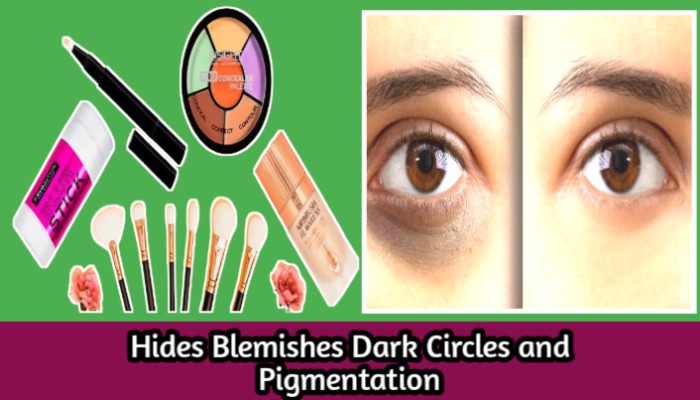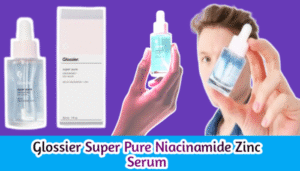Dark circles under the lower eyelids may appear Hides Blemishes Dark Circles and Pigmentation due to genetics, allergies, or other reasons. Home remedies and medical treatments exist that may help reduce their appearance.
1. Common Causes of Blemishes, Dark Circles, and Pigmentation
1.1 Acne and Breakouts
- Clogged pores, hormonal changes, or stress can lead to pimples and spots
- Post-acne marks can leave dark pigmentation
1.2 Sun Exposure
- UV rays trigger melanin production, causing sunspots and uneven skin tone
- Protection with SPF is essential to prevent further pigmentation
1.3 Aging
- Skin thins and loses elasticity over time, highlighting under-eye darkness
- Fine lines can make pigmentation more noticeable
1.4 Lifestyle and Stress
- Lack of sleep, poor diet, and stress contribute to dark circles and dull skin
- Dehydration can make blemishes and pigmentation more prominent
1.5 Hormonal Imbalance
- Hormonal fluctuations can cause melasma, hyperpigmentation, and breakouts
2. Concealers: The Primary Tool
2.1 Types of Concealers
- Liquid Concealer: Lightweight, easy to blend, suitable for under eyes
- Cream Concealer: Medium to full coverage for blemishes
- Stick Concealer: Precise application, long-lasting
- Color-Correcting Concealer: Neutralizes unwanted tones
2.2 Choosing the Right Shade
- For blemishes: Match skin tone exactly
- For dark circles: One to two shades lighter than skin tone
- For pigmentation: Depending on undertone, choose matching or correcting shade
2.3 Coverage Levels
- Sheer: Light correction, natural look
- Medium: Hides mild blemishes and discoloration
- Full: Masks severe pigmentation, scars, or post-acne marks
3. Color-Correcting Techniques
3.1 Green for Redness
- Neutralizes red blemishes and pimples
3.2 Peach/Orange for Dark Circles
- Cancels out blue or purple undertones under the eyes
- Shade choice depends on skin tone: lighter skin – peach; medium to dark skin – orange
3.3 Lavender for Dullness
- Brightens sallow or yellowish skin for a more radiant look
4. Foundations and Their Role
4.1 Medium vs Full Coverage
- Medium: Suitable for everyday wear, evens skin tone without looking heavy
- Full: Best for covering severe pigmentation or blemishes
4.2 Long-Lasting Formulas
- Look for matte, satin, or dewy long-wear foundations depending on skin type
- Waterproof and transfer-resistant formulas help maintain coverage
4.3 Skin Type Considerations
- Oily: Matte or powder foundations
- Dry: Hydrating or dewy foundations
- Combination: Lightweight or buildable formulas
5. Correct Application Techniques
5.1 Using Brushes, Sponges, or Fingers
- Brushes: Precise application, especially for blemishes
- Sponges: Blends foundation and concealer seamlessly
- Fingers: Gentle warmth for under-eye area
5.2 Layering for Natural Finish
- Apply thin layers, build coverage gradually
- Avoid caking to prevent accentuating fine lines
5.3 Setting with Powder or Spray
- Set concealer and foundation with translucent powder
- Finish with setting spray for long-lasting coverage
6. Skincare Products That Support Coverage
6.1 Eye Creams for Dark Circles
- Hydrates and reduces puffiness and discoloration
- Look for caffeine or niacinamide-based eye creams
6.2 Serums for Pigmentation
- Ingredients like Vitamin C, niacinamide, or licorice extract lighten pigmentation over time
6.3 Spot Treatments for Blemishes
- Salicylic acid, benzoyl peroxide, or tea tree oil reduce active breakouts
- Helps make concealer application smoother
7. Tips for Long-Lasting Coverage
7.1 Primers and Base Products
- Use a color-correcting or mattifying primer to enhance makeup longevity
- Prepares skin and reduces oil or dryness
7.2 Setting Powders and Sprays
- Translucent powder prevents sliding or fading of concealer
- Setting spray locks makeup in place for all-day coverage
7.3 Touch-Up Techniques
- Use compact concealer or powder for mid-day fixes
- Blot excess oil before reapplying
8. Common Mistakes to Avoid
8.1 Using the Wrong Shade
- Too light or too dark concealer draws attention to imperfections
8.2 Overloading Product
- Applying thick layers leads to caking and unnatural appearance
8.3 Ignoring Skincare Prep
- Skipping moisturizer or primer can cause concealer to crease or settle
9. Conclusion
Hiding blemishes, dark circles, and pigmentation requires a combination of proper skincare and smart makeup techniques.
- Skincare: Treats underlying causes like acne, pigmentation, and dryness
- Makeup: Concealers, color-correctors, and foundations provide immediate coverage
- Techniques: Correct application, setting products, and touch-ups ensure natural, long-lasting results










